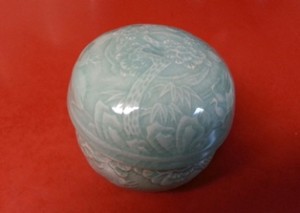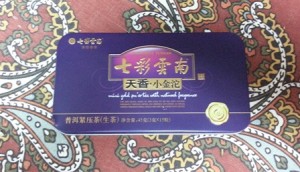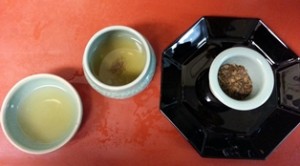It’s time for a tea post.
My sister gifted me with some tea, really nice tea, from China. Pu’erh to be exact. So, I stuck it on my shelf and admired the beautiful case, thinking “I can’t drink that, it’s too nice. I couldn’t make it right.”
Well, 2014 is for living and for action, so, I decided to cross pu’erh tea off my list today .
What better to brew this tea than the celadon my Aunt gifted me from a trip to China she had a few years ago.
I have no idea how to make Pu’er tea, so I turned to the internet. After a little reading I discovered pu’erh is not your average brew.
The several sites I referenced agreed on the basics. Pu’erh comes in a few different forms. Basically, you can have loose leaf or cake, raw (young) or fermented (ripe). And the first step is to rinse the tea. And you can steep it several times once rinsed. Since it is typically prepared in a tiny cup, steep time is always about 10-20 seconds, longer the more you steep it.
My tin case came with ten pre-measured single serving sized cakes.
I know I have a raw type from Yunnan from searching the package. Thank you Internet! Since the box is printed ALL in Chinese, I have no idea what it says though.
Take 1
To be honest, my first thought was “why waste good tea?” So I skipped the rinse step being a frugal young woman stuck in the leaves poured the water and let it go. Big mistake! It was so bitter I spat it right into the sink and dumped the cup, leaves and all. I wasted a whole cake. L
Take 2
The sage advice of the internet finally got my attention. I stuck the cake in the celadon strainer and just covered it with boiling water. I poked at it (technical terminology) with a spoon until it all fell apart and drained it/dumped the rinse water. This no longer pained me, it is NOT worth drinking.
I topped off the cup with more boiling water and let steep for 20 seconds. It was dark and rich smelling. The leaves smelled very fragrant. But it was so hot! Fortunately the trick with the celadon is that you pour some into the lid so it cools quickly and you can sip it. Genius!
This time, it tasted like good tea–a million times better than the unrinsed batch. I couldn’t believe it.
I put the leaves under again for 20 seconds. Still delicious. This continued until steep number 4. I’m chicken to steep tea longer than 30 seconds. I don’t enjoy bitter tea, so I’m hesitant to steep this stuff longer.
What I will do differently on take three:
- I won’t use boiling water
- I’ll break up the cake before rinsing
- I’ll try steeping it for up to 40 seconds on the 4th steep.
What makes Pu’Er so special Anyway?
- From what I gathered pu’er comes from a specific varietal of the tea tree (Camellia sinensis), which has broader leaves.
- Pu’er tea actually gets better with age (like wine)
- You can use boiling water to steep it (if it suits your taste)
I referenced Horse Road Tea, Tea Vivre and Bana Tea Company for tea brewing tips.




Very cute and well written. Of course I expected nothing less. However, having only recently acquired a taste for spiced chai, this old bag will stick to the basics.
🙂 Like your Ultra Spice this too was a gift I may become addicted to. It’s a bit more labor intensive, so who needs that–too often anyway? I thought it was time to jump off into true tea geekery.